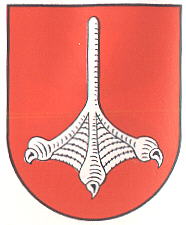Önsbach: Difference between revisions
Jump to navigation
Jump to search
Knorrepoes (talk | contribs) m (Text replacement - "/Arms of " to "/Arms (crest) of ") |
Knorrepoes (talk | contribs) m (Text replacement - "{{media}}" to " {{de1}} {{media1}}") |
||
| Line 25: | Line 25: | ||
The oldest known seal dates from around 1830 and shows a bird's claw n a crowned shield. The meaning or origin of the claw is not known. In 1913 the present arms were devised, based on the old seal. The claw was now specified as a duck's claw and the colours are the old colours of the Ortenau area. | The oldest known seal dates from around 1830 and shows a bird's claw n a crowned shield. The meaning or origin of the claw is not known. In 1913 the present arms were devised, based on the old seal. The claw was now specified as a duck's claw and the colours are the old colours of the Ortenau area. | ||
{{ | |||
{{de1}} | |||
{{media1}} | |||
[[Civic Heraldry Literature - Germany|'''Literature''']]: Zier, 1964. | [[Civic Heraldry Literature - Germany|'''Literature''']]: Zier, 1964. | ||
Revision as of 11:49, 26 December 2022
This page is part of the German heraldry portal Deutsche Wappensammlung |
Heraldry of the World |
|
German heraldry:
|
Selected collector's items from Germany:
|
ÖNSBACH
State : Baden-Württemberg
District (Kreis) : Ortenaukreis (until 1972 Bühl)
Incorporated into : 1972 Achern
| German | In Rot ein silberner Schwimmfuß. |
| English | No blazon/translation known. Please click here to send your (heraldic !) blazon or translation |
Origin/meaning
Önsbach was part of the Ortenau district and was a separate village, but has always been part of the district of Achern. In the early 19th century it became a separate municipality until 1972.
The oldest known seal dates from around 1830 and shows a bird's claw n a crowned shield. The meaning or origin of the claw is not known. In 1913 the present arms were devised, based on the old seal. The claw was now specified as a duck's claw and the colours are the old colours of the Ortenau area.
Literature: Zier, 1964.


